Thursday 28 December
The ferry leaves at 9:00 and I planned to leave the hostel well before 8:00 to make sure I would certainly be on time. By about 7:00 I had all my bags packed and went downstairs. The manager was preparing breakfast and said it would be available at 7:30. He also said that 8:00 would give me plenty of time to catch the ferry. Thus I sat down in the common room with one of the hostel’s books to wait for breakfast. And boy am I glad I waited! This was probably the best breakfast I had in South America, with yogurt, cake, fresh fruit, bread and even an omelet. I was the first at the breakfast table and also the first to leave just before 8:00. The ride to the ferry terminal is about 6 kilometres, so no problem there. It is still a good idea to arrive early, since there was quite a long line of people waiting to buy a ticket. Cyclists only need a passenger ticket, the bike is taken on for free.
The boat is quite a lot larger than the other ferries I’ve been on, with room for several large trucks as well as a number of cars and hundreds of people. It’s also the first roll on-roll off ferry. Up to now I had only seen smaller boats onto which cars had to enter in reverse. It was a beautiful morning for a boat ride with sunshine and once we got moving there was effectively no wind on the boat, as its velocity matched that of the ship. But of course this wouldn’t be Patagonia if it stayed that way. We arrived two hours later in Porvenir with a rather different wind and rain. During the ride I felt extremely happy and a bit strange to finally be going to Tierra del Fuego, pretty much the end of the Earth and my goal for such a long time.
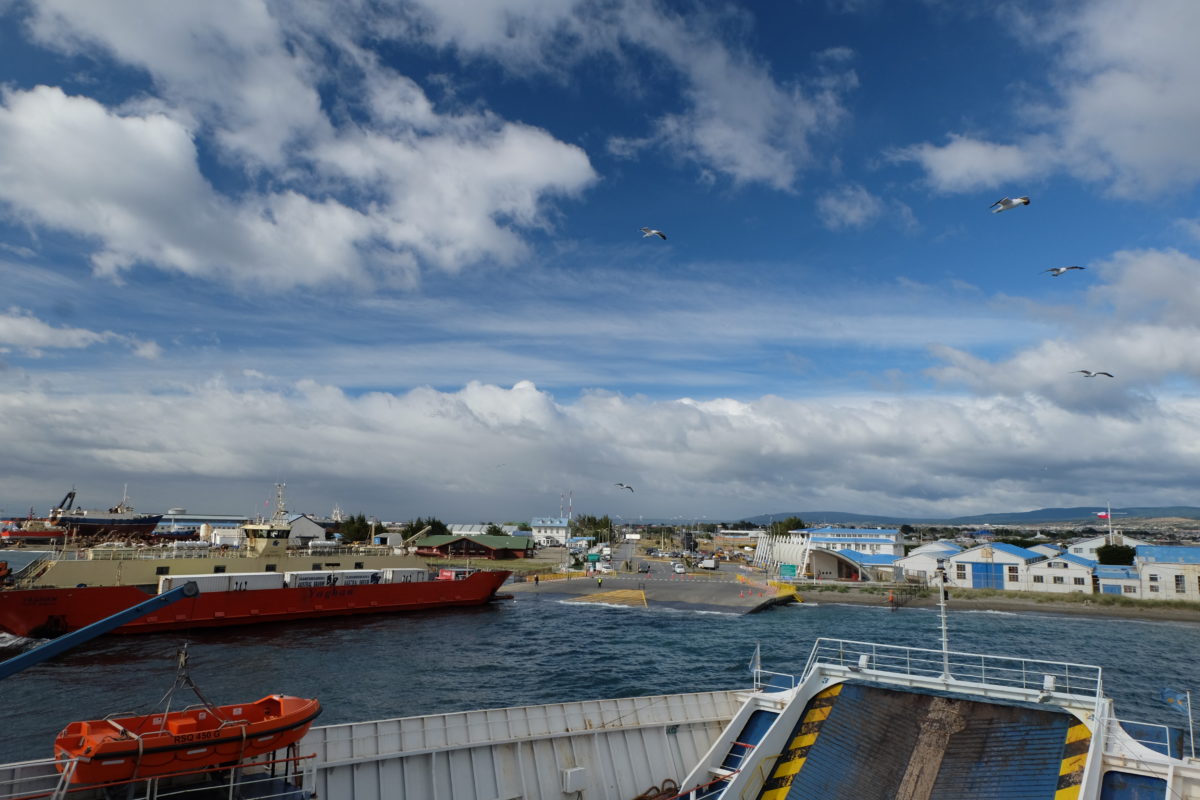
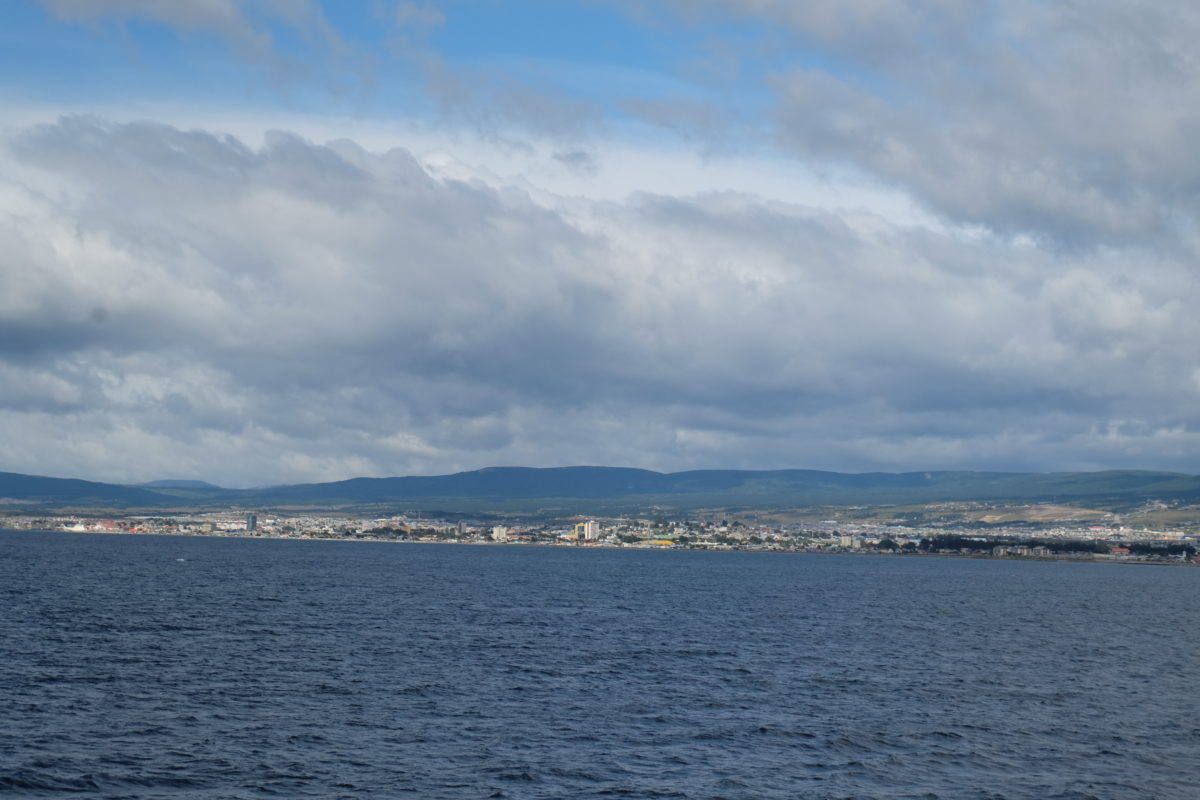
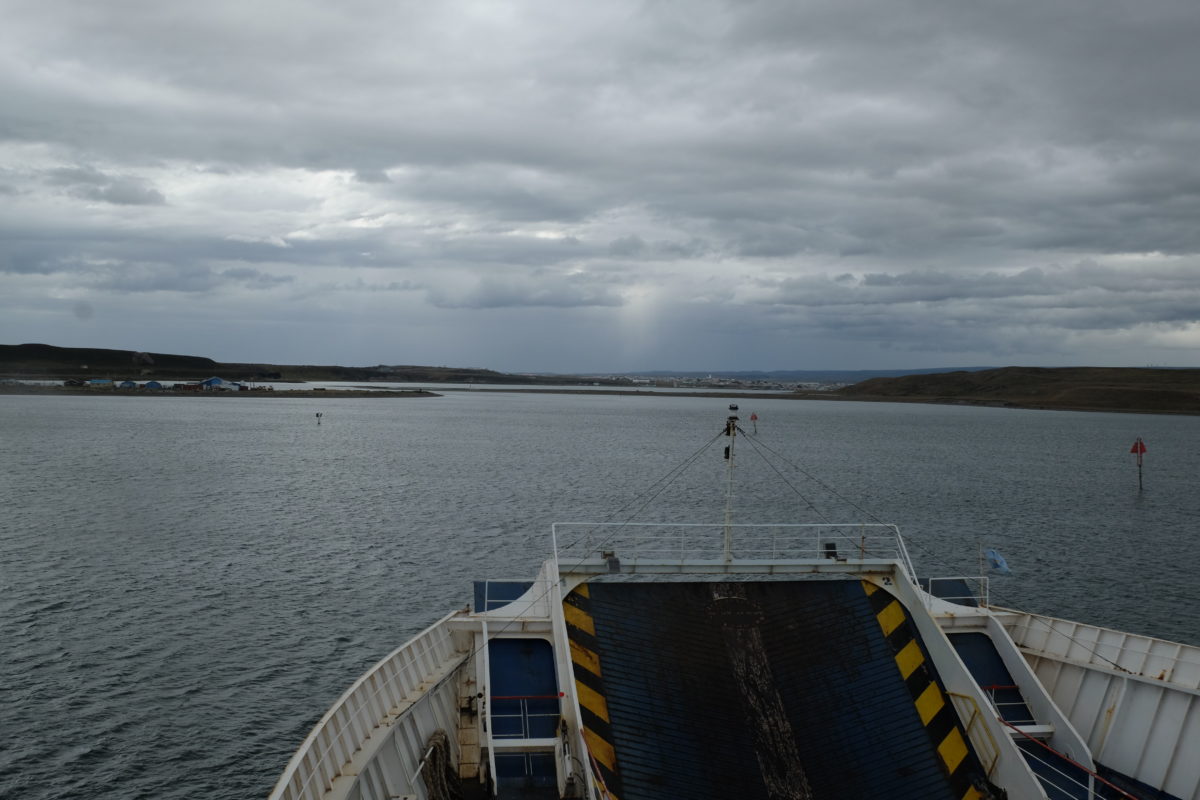
Three other cyclists were on the boat, one who stayed at the hostel as well and two I met last week on the windy day into Cerro Castillo. They didn’t make it then and hitched part of the way the day after. Everyone seems to be aiming for the little refugio at the Onaisin crossroads some 100 km east of Porvenir.
| Elapsed Time | Moving Time | Distance | Average Speed | Max Speed | Elevation Gain |
|---|---|---|---|---|---|
|
10:49:28
hours
|
06:50:48
hours
|
110.42
km
|
16.13
km/h
|
33.48
km/h
|
811.00
meters
|
I think I took a wrong turn out of town and thus rode a slight detour, but nothing serious. Many people say the north of Tierra del Fuego is extemely flat, but the first section out of Porvenir is surely an exception. The elevation differences are not that large, but the climbs are sometimes very steep. Combined with the ripio road it reminds me of the Carretera Austral, but the landscape is quite different. The road soon reaches the coast of Bahía Inútil, which stays on the right all day. To the left are small hills that you occasionally enter. The wind appeared to be from the north, which was less than useful for me and occasionally even worked against me. Then 40 km from my goal I passed a junction and it was like a switch got flicked. The climbs were gone and instead I was on a flat (almost Dutch-flat) road with a strong breeze in my back. Where it was cloudy with some rain before, now the sun came out to make the last part very good.
I saw much wildlife next to the road, including guanacos, geese, gulls and foxes. They often scare away long before I’m there, so I don’t have good photos of the smaller animals. On several occasions did I see a guanaco hop over the fences lining the road with impunity, even from a standstill. Some 85 km outside Porvenir I saw a dark spot in the landscape that I didn’t recognise. When I got closer I saw it was a line of trees, the first of the day as far as I remember, though there were some more afterwards. They all have a strong preference to grow toward the east.
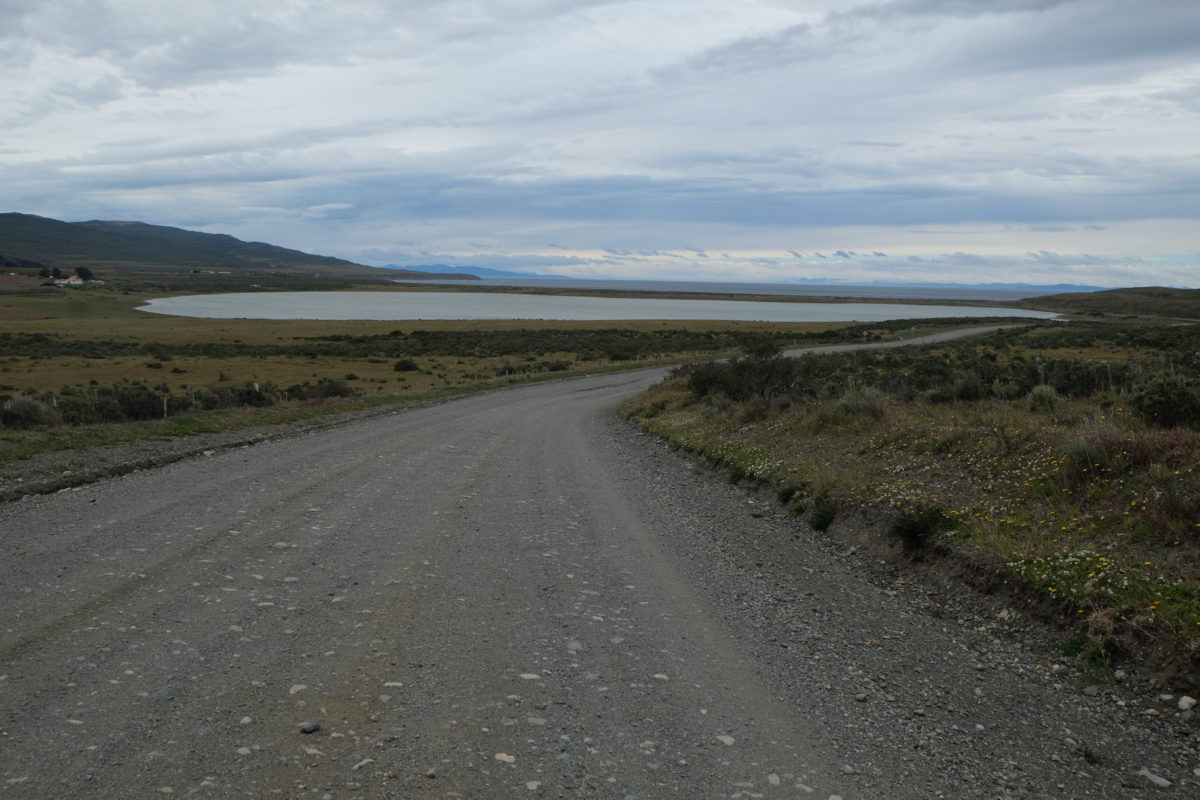
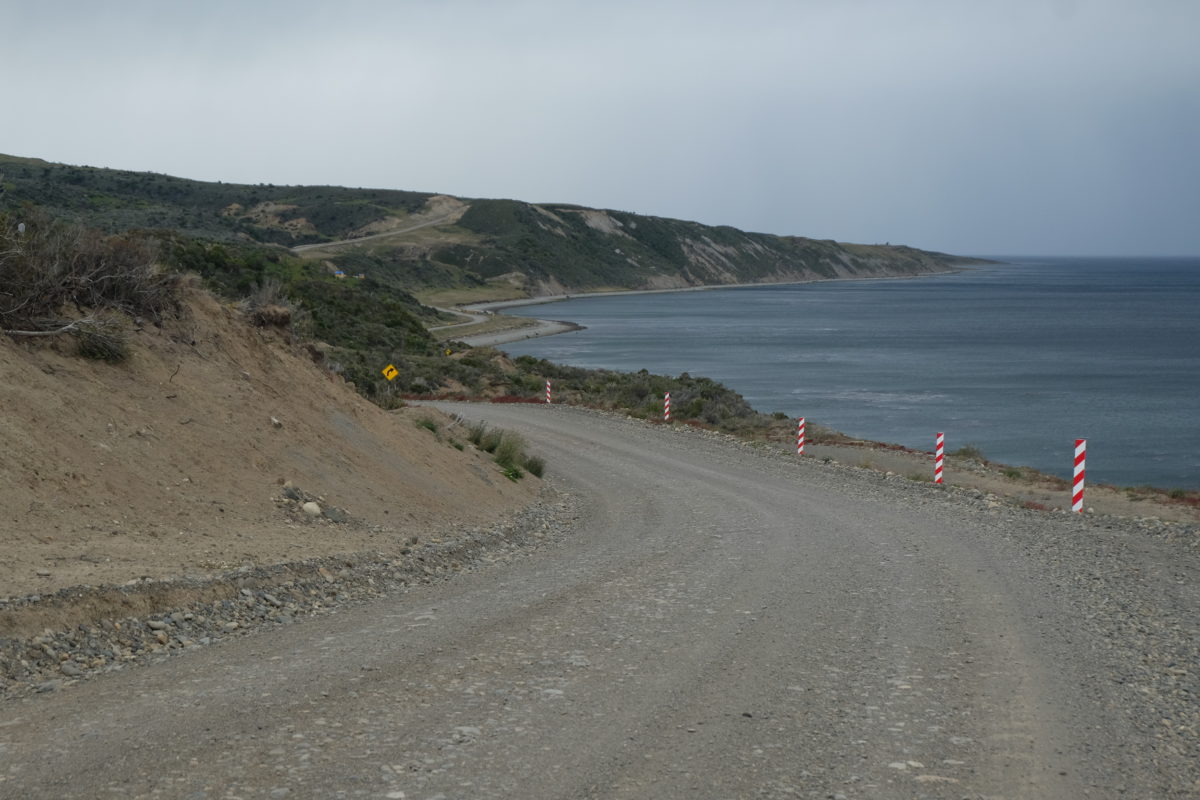
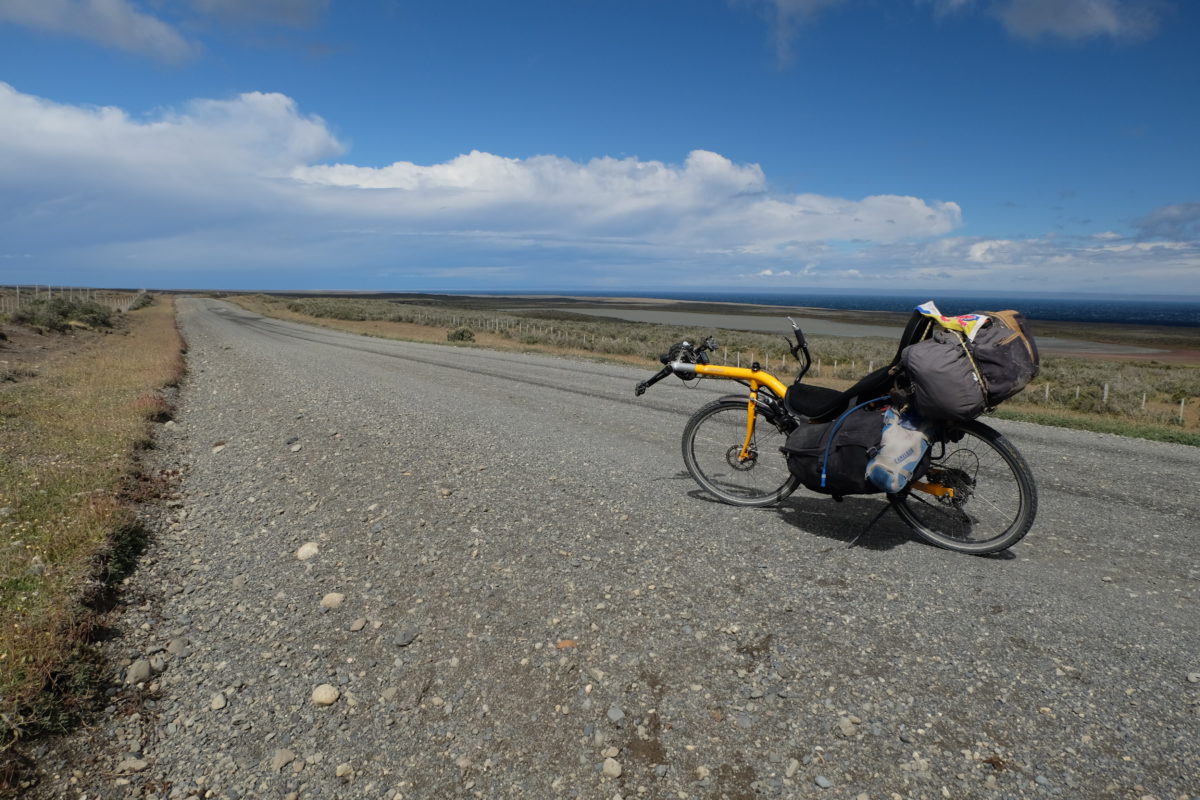
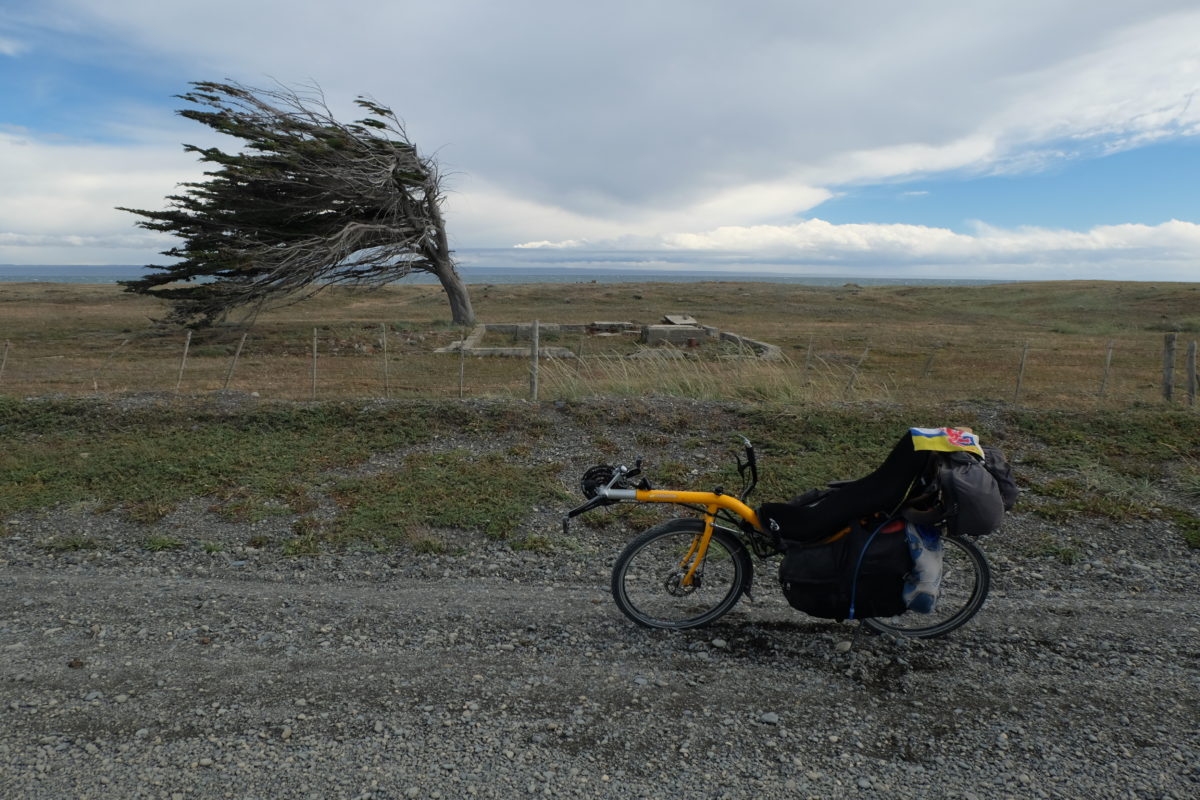
I was the first to reach the “refugio” just before 19:00, which is a simple wooden room sitting by an intersection of several roads. Previous users dubbed it the “Casa del Cyclista Onaisin”, which is pretty much all that the “town” of Onaisin has to offer. When riding with a tailwind it doesn’t feel all that strong, but after stopping the wind seemed to be much stronger and it sounded almost like a storm outside. None of the others showed up that night. For the first time I left a message of my own at the refugio, which William promptly found the next day.
My camera’s photo counter rolled around today, meaning I took 10,000 pictures in the almost 3 years since I bought it. Most of them are while travelling and over half are from the last few months in South America.
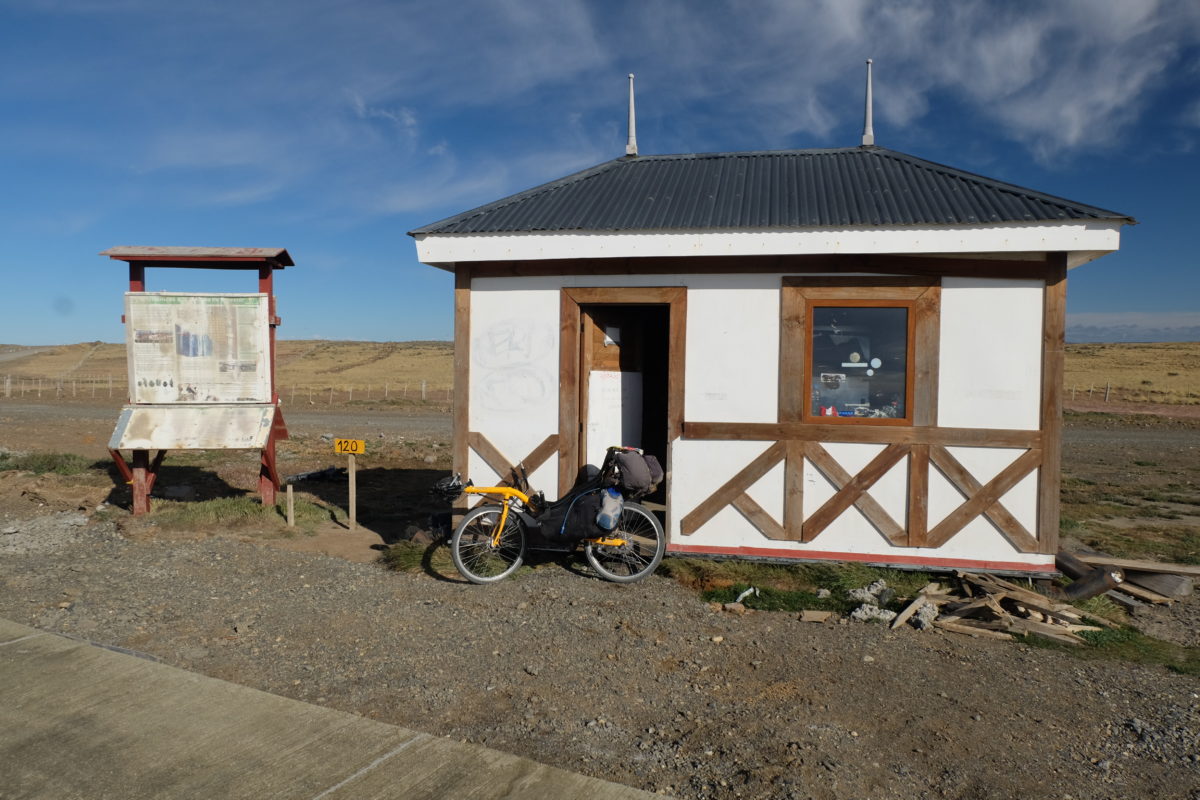
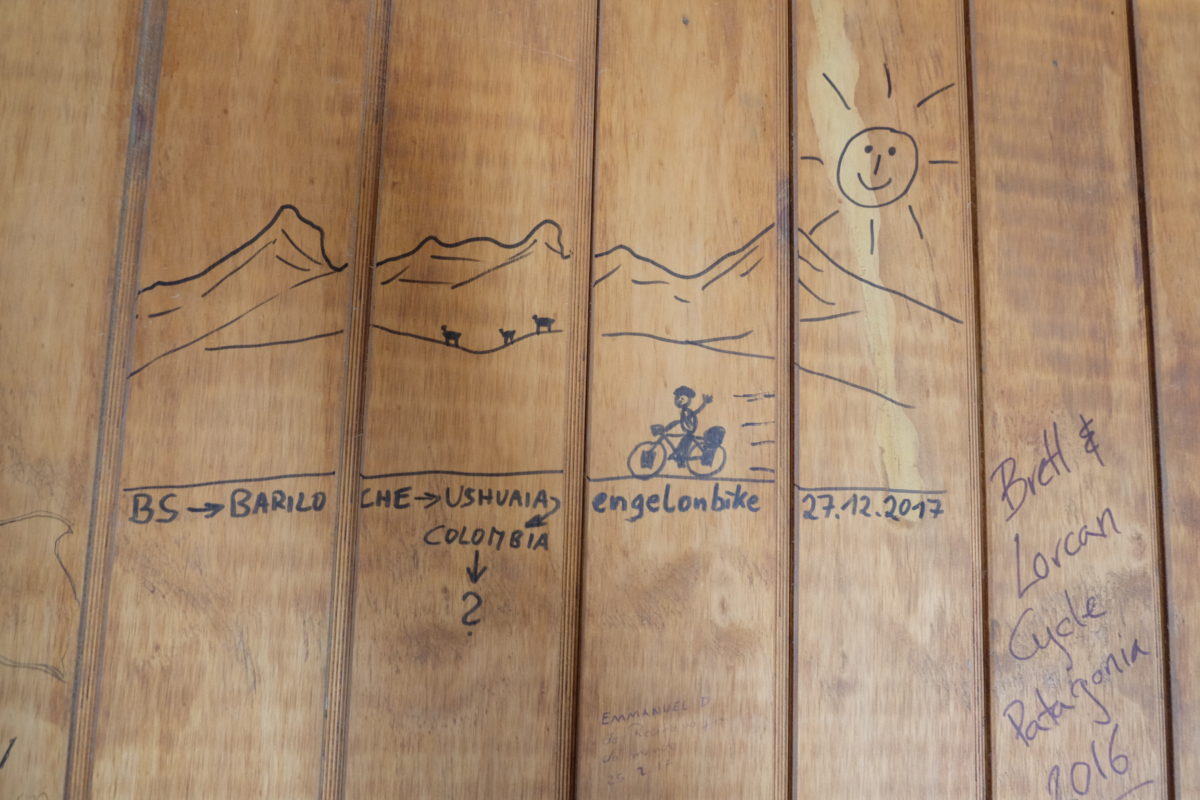

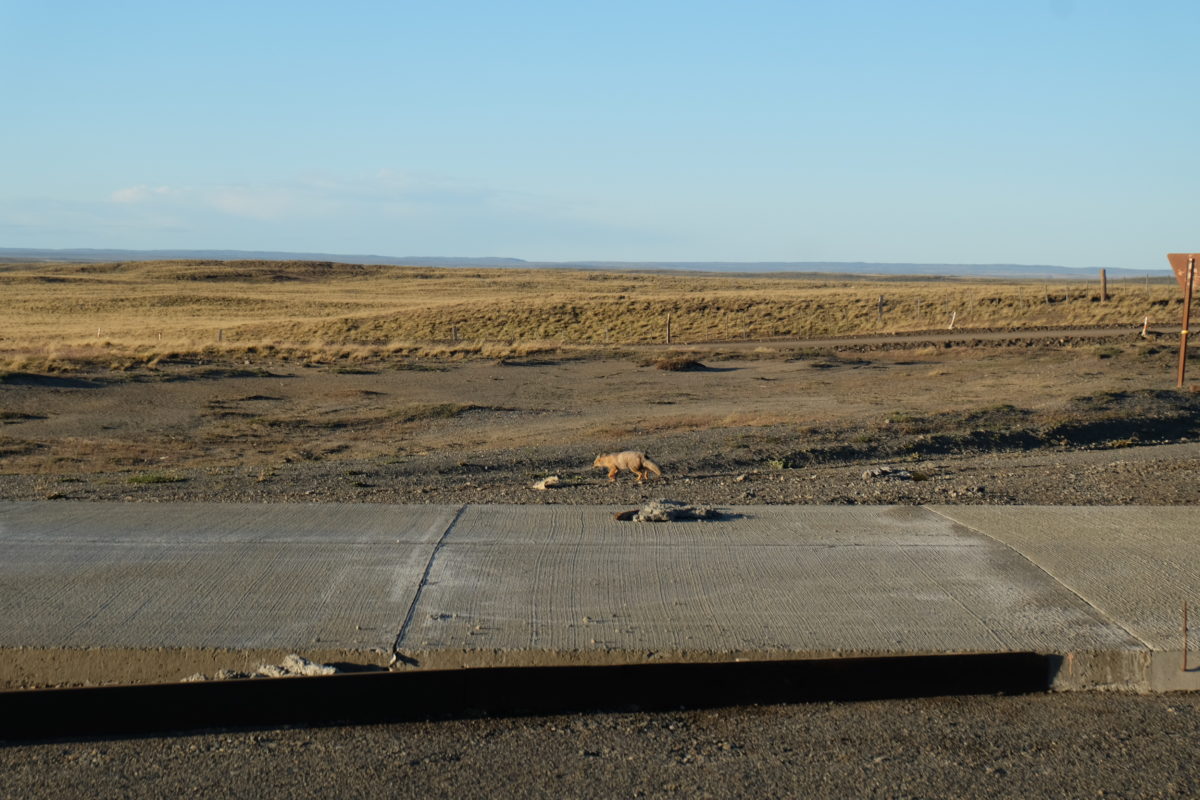
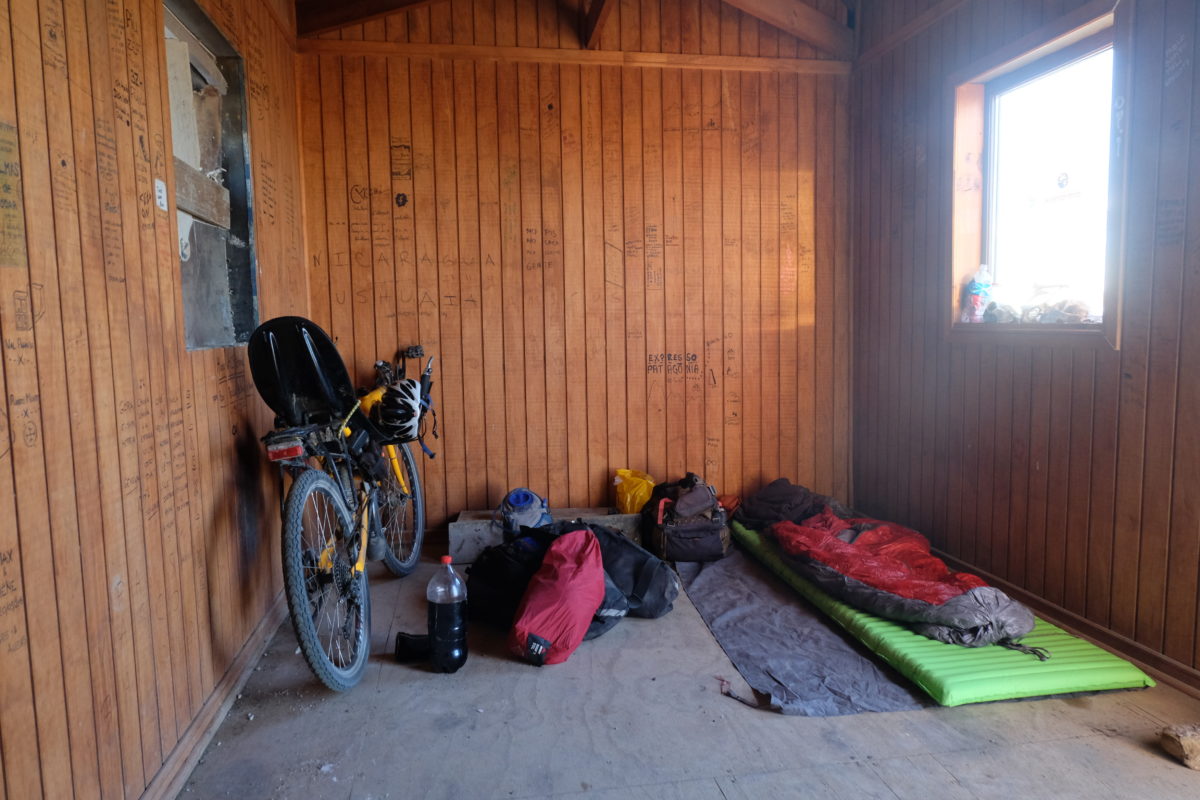
Friday 29 December
Friday started with a loud bang on the door, though I didn’t see anyone when I got up and opened it. It was a good time to get started, so that’s what I did. As I was eating I heard someone taking shelter behind the building and making a phone call. I don’t know how he got there or what he was doing.
| Elapsed Time | Moving Time | Distance | Average Speed | Max Speed | Elevation Gain |
|---|---|---|---|---|---|
|
10:33:19
hours
|
06:25:52
hours
|
90.04
km
|
14.00
km/h
|
34.20
km/h
|
1,237.00
meters
|
I took off south at 8:30 with the wind in my back. That agrees with predictions I saw before, but I didn’t dare believe them until I saw it. I quickly covered the 15 kilometres to the main attraction in this region. I ask you: What’s better than going penguin spotting? Doing it twice in three days of course, and with bigger penguins this time! Some years back a small colony of king penguins arrived here and they never left. This is the second-largest penguin species, but emperor penguins only live on Antarctica. These look the same but slightly smaller and this is the only easily reachable colony of them, with all others living on very remote islands. It’s a small colony and you don’t get as close as to the Magellanic penguins. There is a good telescope at the viewing site to observe them, but with my pathetic 50mm lens I don’t have close-up photos like before. Another group was there carrying devices that looked like rocket launchers with cameras mounted at the end of the barrel.
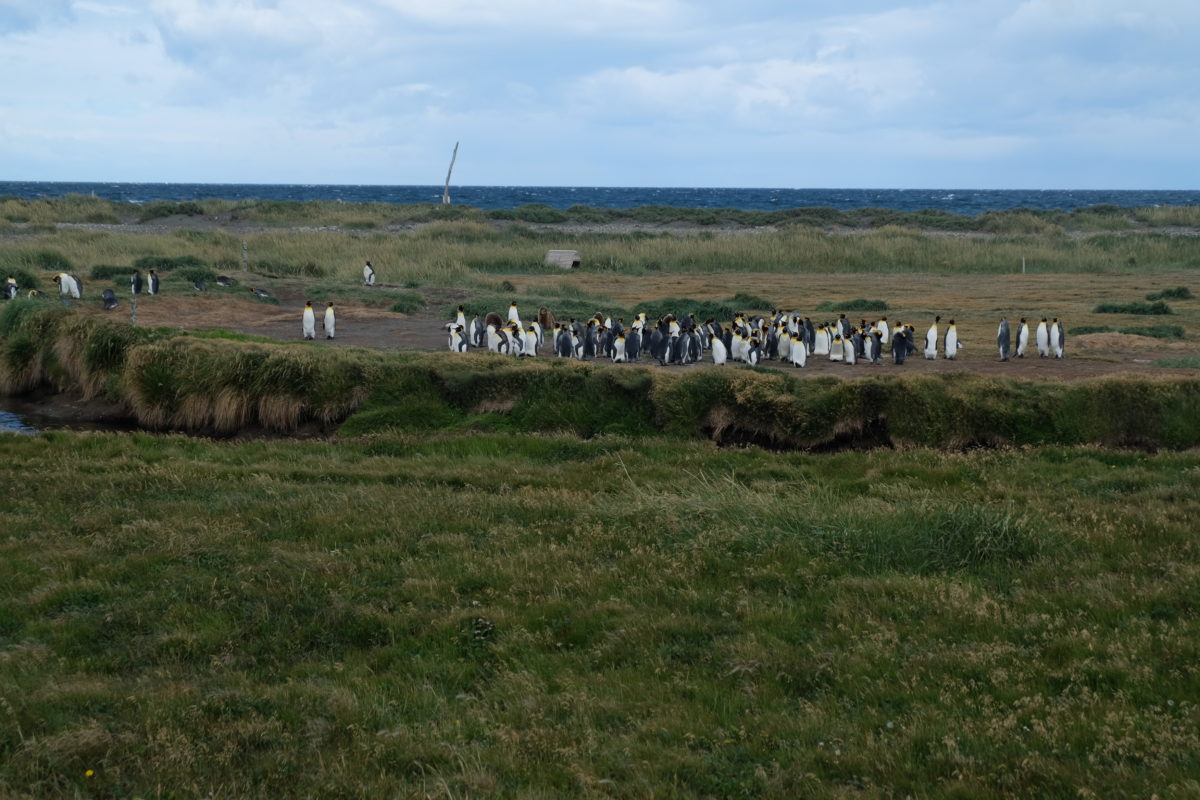
At some point a very strong wind started from the west. When I got back to the building they said it was about 90 km/h, which is not that special here. Yet it’s not something I would like to fight against, as I would on my planned route.
Most people head back to the main road and then fly straight to Río Grande on mostly paved roads with the wind in their back. I had heard from multiple people, both online and in person, that the more southern route is much nicer and since I have plenty of time I wanted to try that. It’s longer and all gravel, but that’s fine. The bigger problem is that it goes southwest for about 30 km to Cameron, so with this storm starting up that wasn’t looking so attractive. On the other hand, even if I just get to Cameron today I should be fine in my planning.
I waited out the wind inside with some other cyclists I met on the Carretera Austral and who took the other ferry to Tierra del Fuego. The people here kindly gave us water and even filled our thermos bottles with hot water. Soon the wind reverted to its previous direction and strength and it was time to leave. The others were going back to the main road, so I continued south alone. The wind was quite good here, at least not working against me until I was close to Cameron.
This little village was a bit surprising. I saw its population listed online as 62, but it’s certainly larger than that. It’s also quite idyllic with its location in a little river valley that ends at the bay. It was only 15:00, so I decided to just rest and eat for a bit, then continue with the wind in my back now.
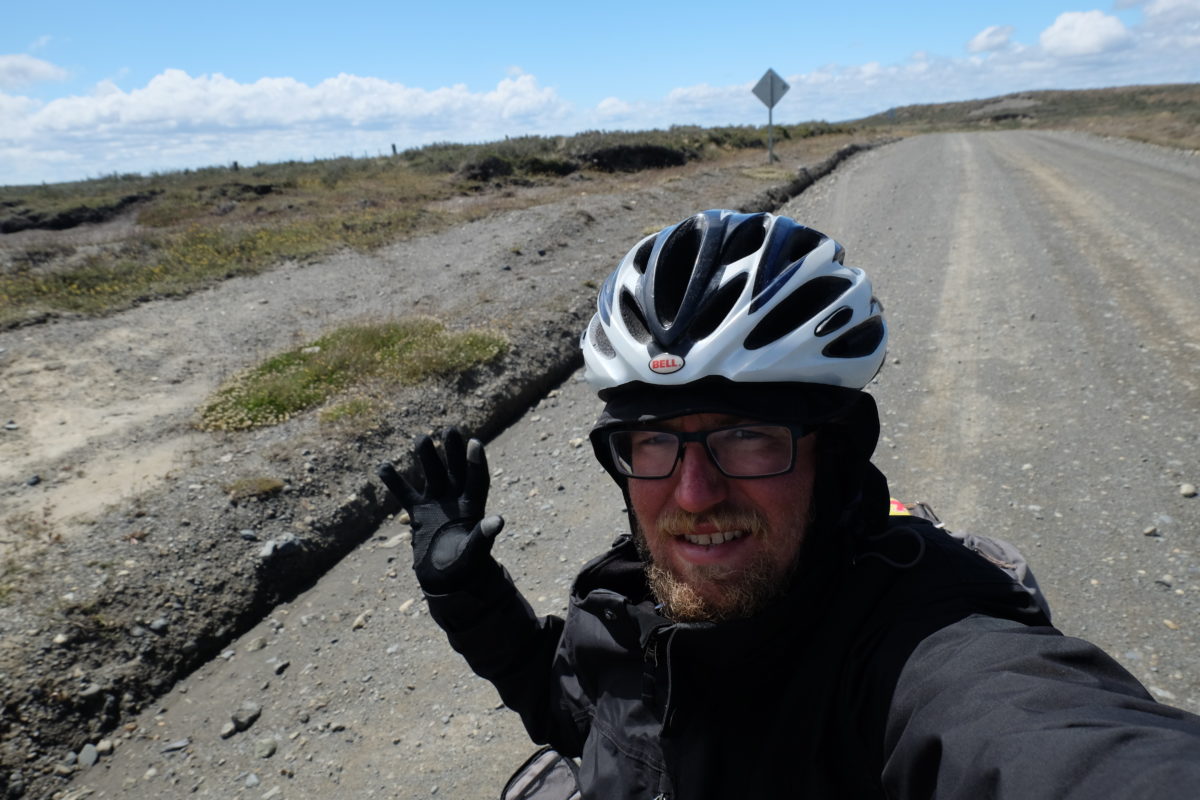
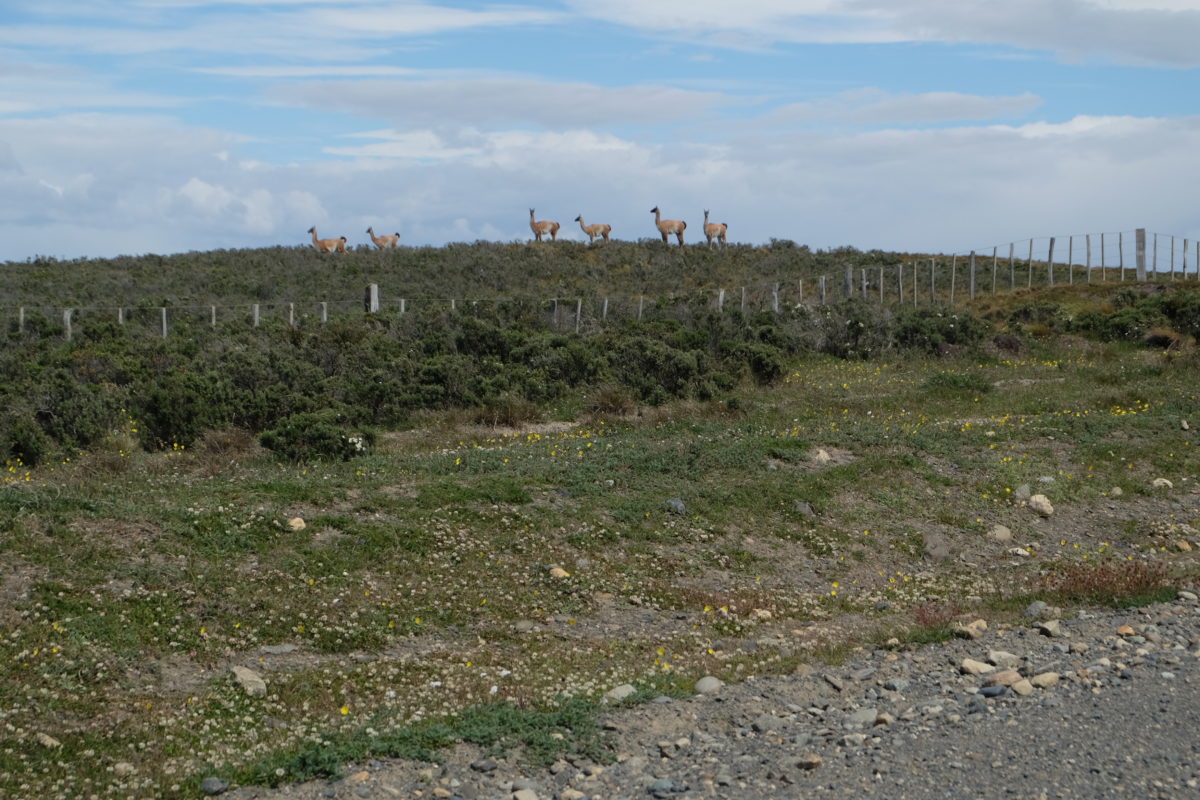
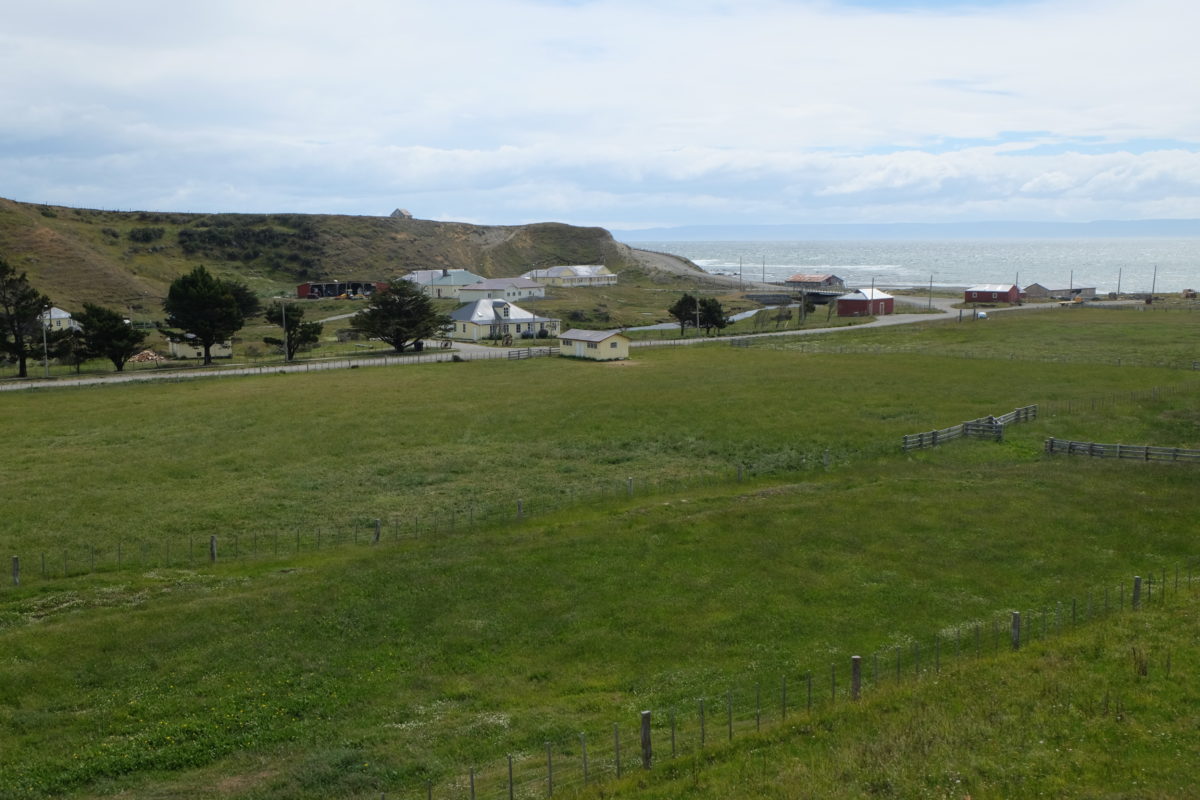
The second half of the ride was thus much easier. The climbing was all very gentle and the road was good. Normally I don’t want to go too fast on ripio, but today I went about 30 km/h on some sections without feeling that it was a problem and without pedalling either.
After some initial climbing I got to a few very beautiful gently rolling plains and a bit later I even saw a few forests. I’m glad now I took this road and not the boring (or so I’ve heard) main road, even if it’s a bit tougher. Somewhat later I saw a machine that was left from the gold rush that took place here a little over a century ago. I then passed through Russfin, a mostly abandoned village. Just past that it started to rain just as I reached a hotel that mainly houses logging and sawmill workers, but also caters to the few tourists that visit this remote corner. At first I only got crazy expensive offers, but when I walked out to find a wild camp somewhere she offered me a reasonably priced double room which I may have to share if someone shows up. The room was OK, but in hindsight I might as well have stayed in one of the buildings in Russfin.
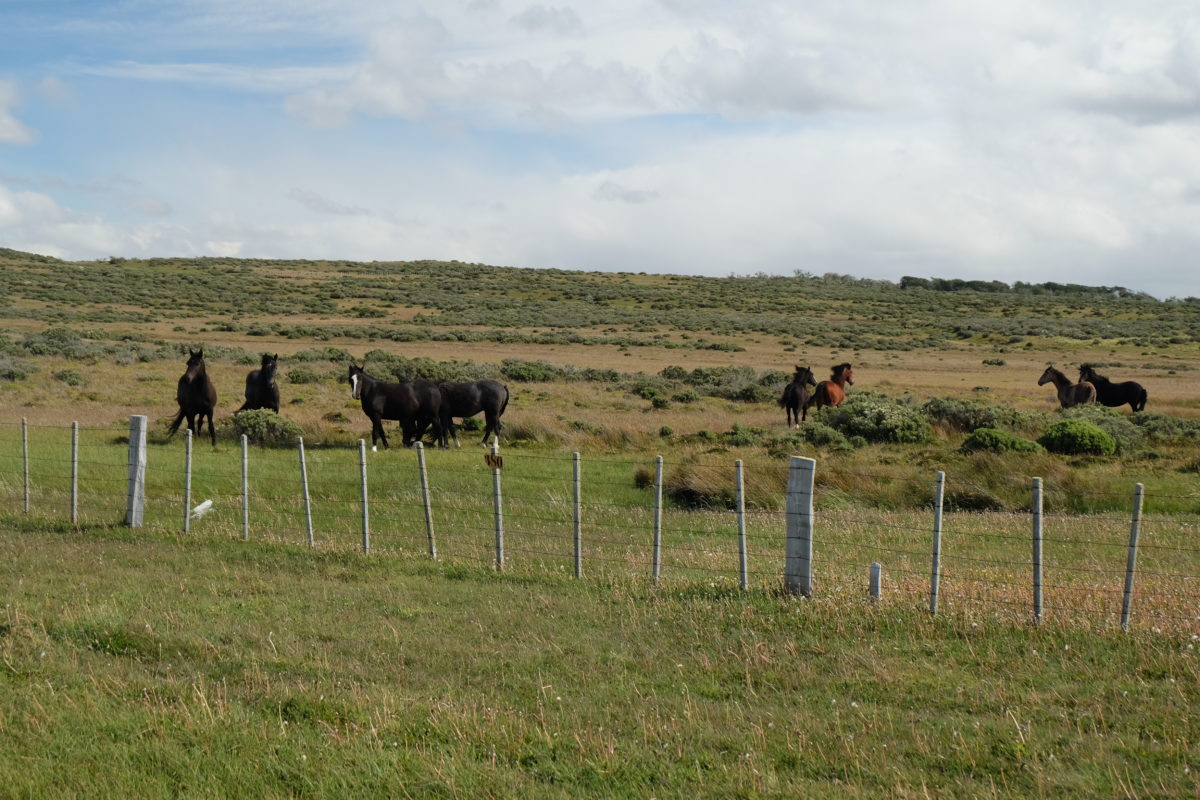
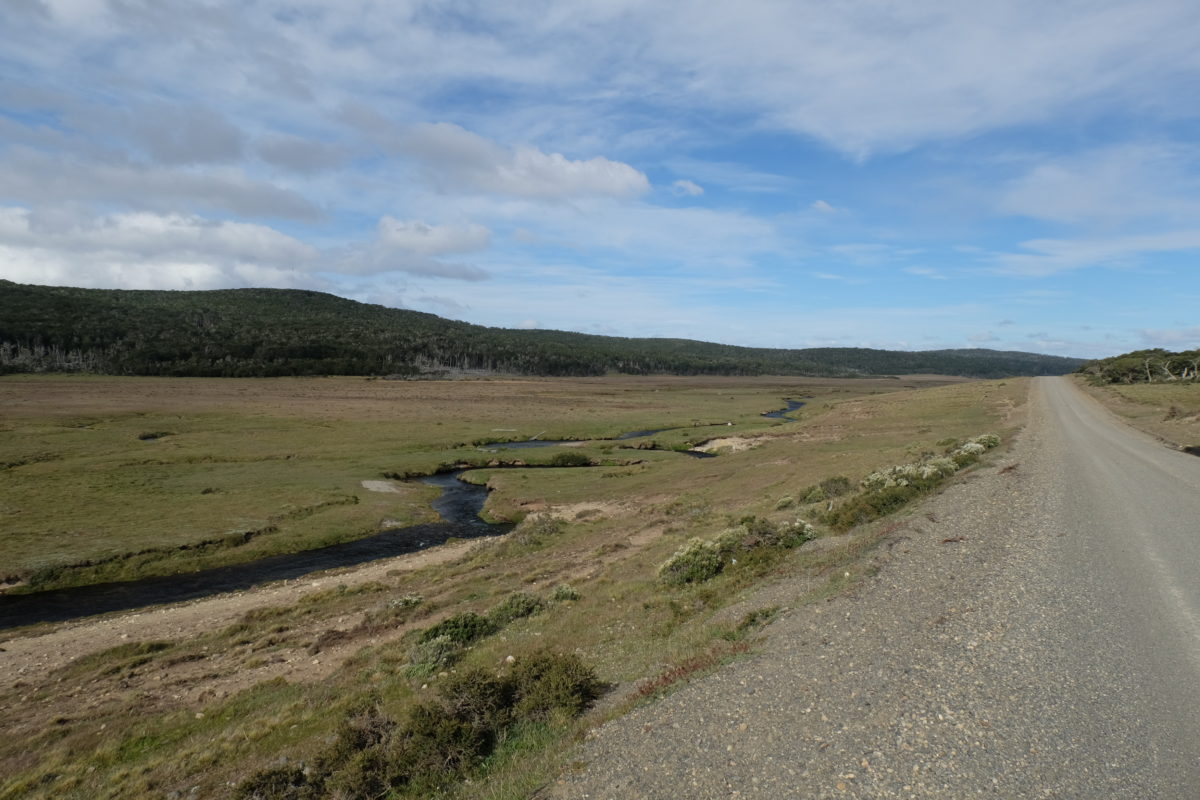
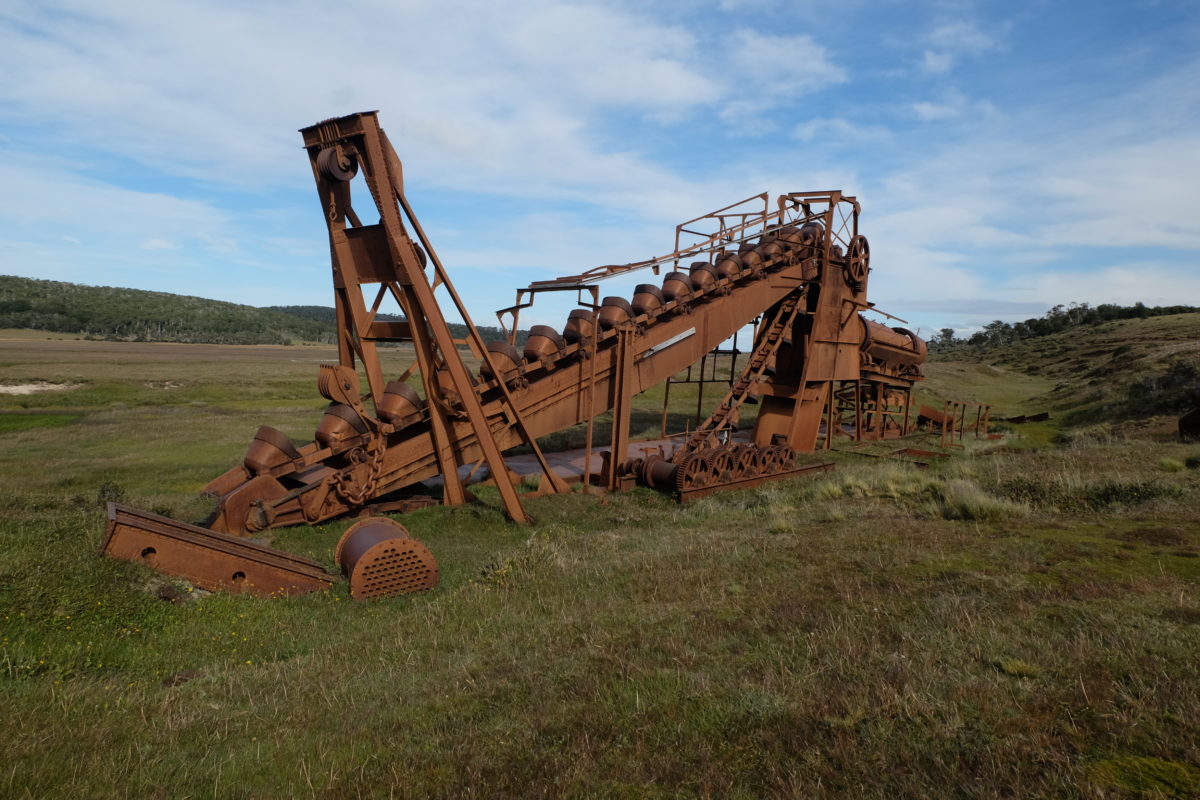
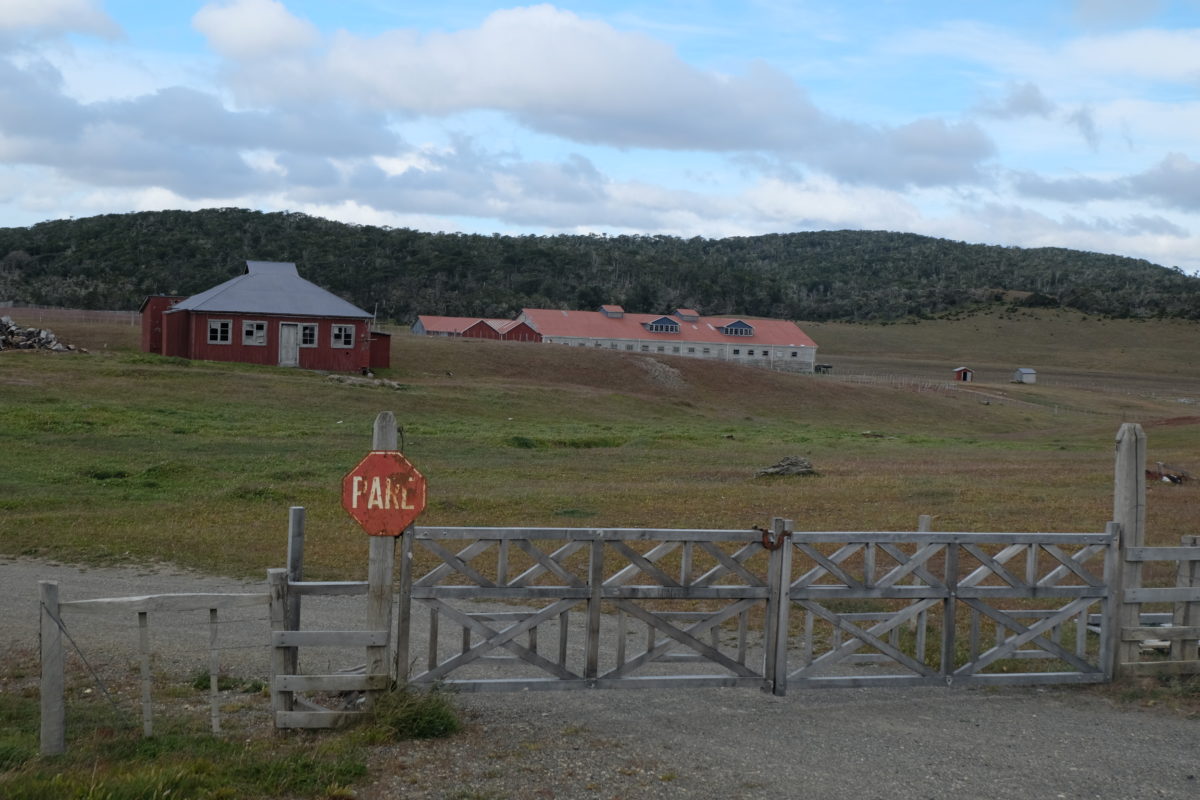
I planned four days for the 320 kilometers on this route and if today had been a hard day as expected that would have worked out nicely. I’m now “worrying” that I’m going “too fast” on this route. If I put in a long day tomorrow I could reach Río Grande a day early, which I then have to fill up somehow, and otherwise I’m likely to be there very early the next day. But I’m not the kind of guy to sit around in the middle of nowhere waiting until the day is out and the new day comes around. When I don’t have a specific target I’ll just keep going until the day is almost over.
Saturday 30 December
| Elapsed Time | Moving Time | Distance | Average Speed | Max Speed | Elevation Gain |
|---|---|---|---|---|---|
|
09:47:32
hours
|
08:23:40
hours
|
145.80
km
|
17.37
km/h
|
37.80
km/h
|
1,148.00
meters
|
Saturday started with breakfast in the cantina for the workers. The ride was initially fast and easy. Another advantage of a recumbent bike is that it’s very easy to look around you at the surroundings. But that doesn’t mean you should do that all the time. Early on I was looking up at a goose flying by and thus not at the road. I accidentally left the narrow lane of hard-packed soil, lost grip in the loose rubble and fell. No big deal, pick up the bike and continue. But not this time: In the fall my bar end shifter caught on the ground and tried to shift without the chain moving. This in turn caused my already bad shifter cable to fail. Thus I lost about 15 minutes replacing it. I guess that’s one way to get rid of too much time, but not how I envisioned it.
A little more careful now I continued, often with the wind at my back, but not always. I passed a few small settlements and enjoyed the rest of my private safari, including several condors and also some interesting forest. The first two hours I saw no one else on the road and after that a few cars per hour.
I reached the Paso Bella Vista border at about 13:00 and was the only one there. Unlike the Villa O’Higgins crossing this one has all the usual services. The customs guy asked if I had a declaration form for the bike and when I answered in the negative he wanted to know where I entered Chile, presumably so he could complain about his colleagues. Everyone (read: The 3 officials and the son of one of them) came outside to watch me leave.
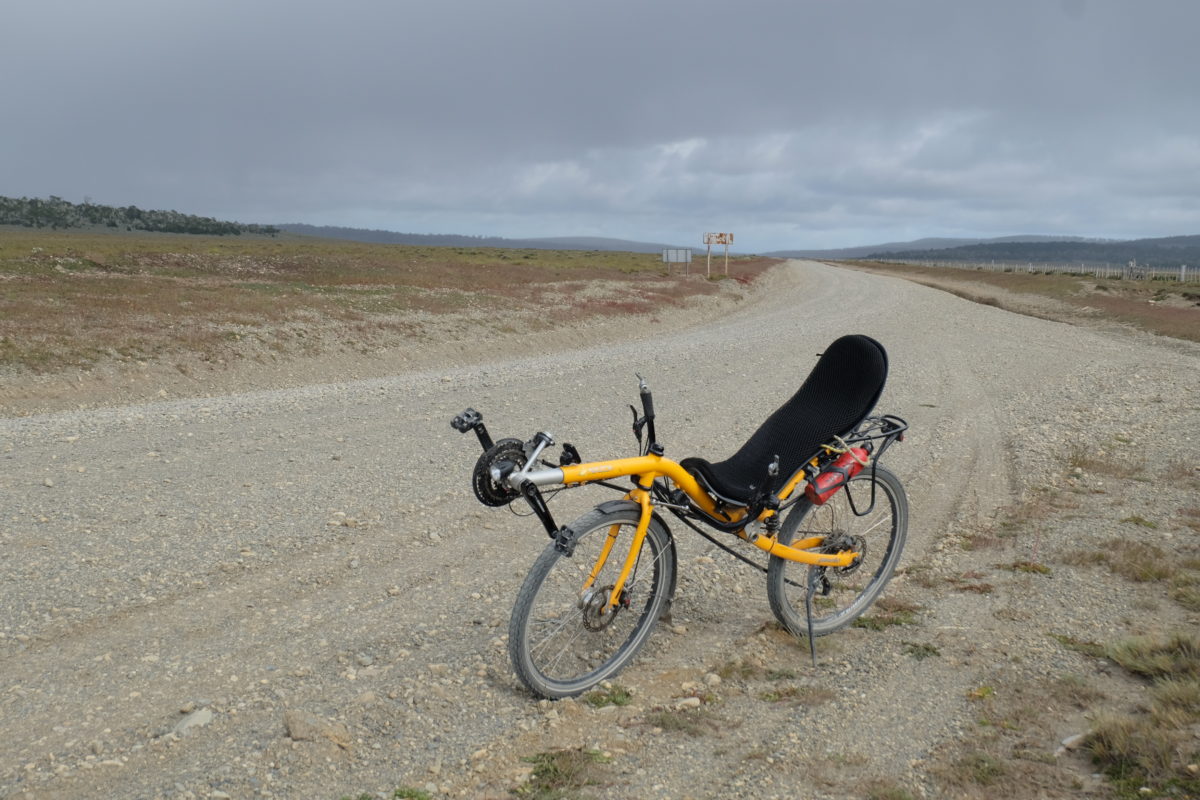
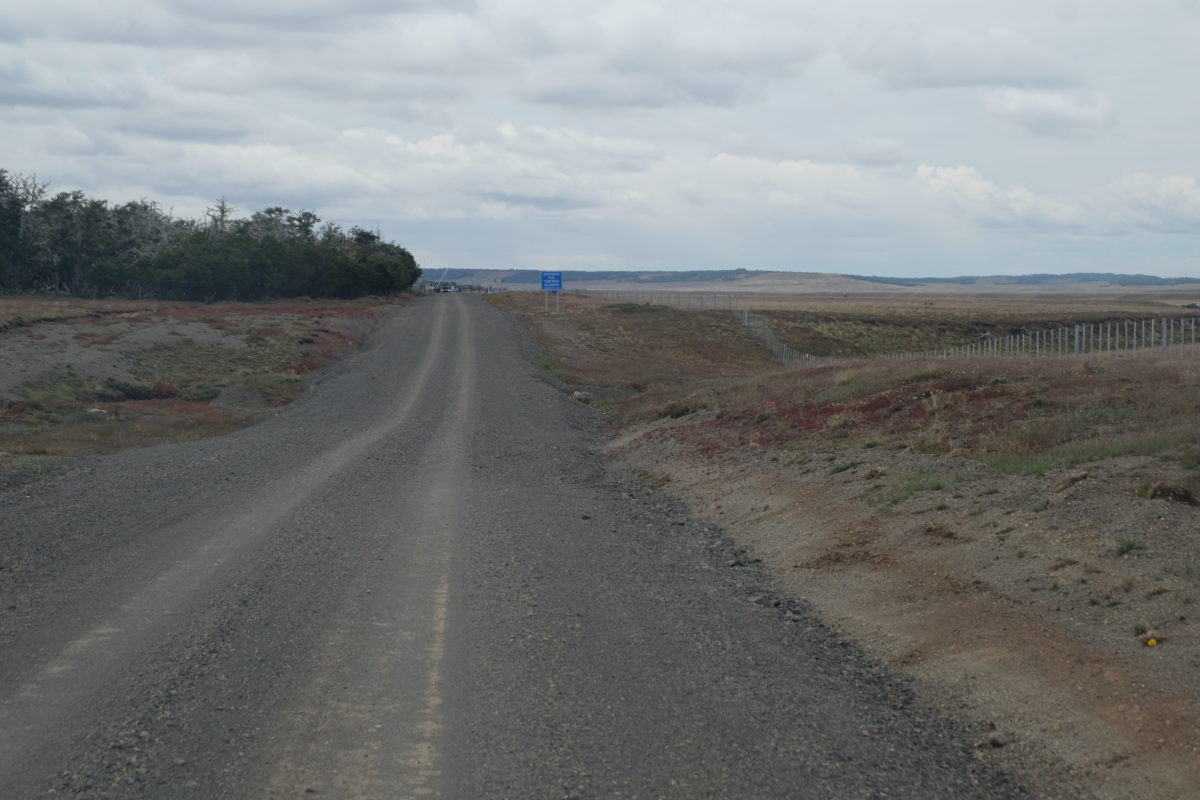
In ye olden days (read: up to a few years ago) this crossing was for real heroes, as you had to go through the river, which is cold and sometimes rather deep. Then they installed a “bridge”, but wide or heavy vehicles still had to go through the water. These days there is a real bridge for everyone. On the Argentinian side it took a while until my presence got noticed and they found the right person to check me in. There are computers here, but he still wrote down my information on paper instead.
Today’s route, like yesterday’s, has quite a bit more climbing than I expected. None of them are big, but some are steep and hard while others are easy with the wind helping me up. The road was mostly good, but the Argentinian side has some sections of very bad washboard too. You don’t see them coming, so you’re just suddenly jostled around until you can slow down enough.
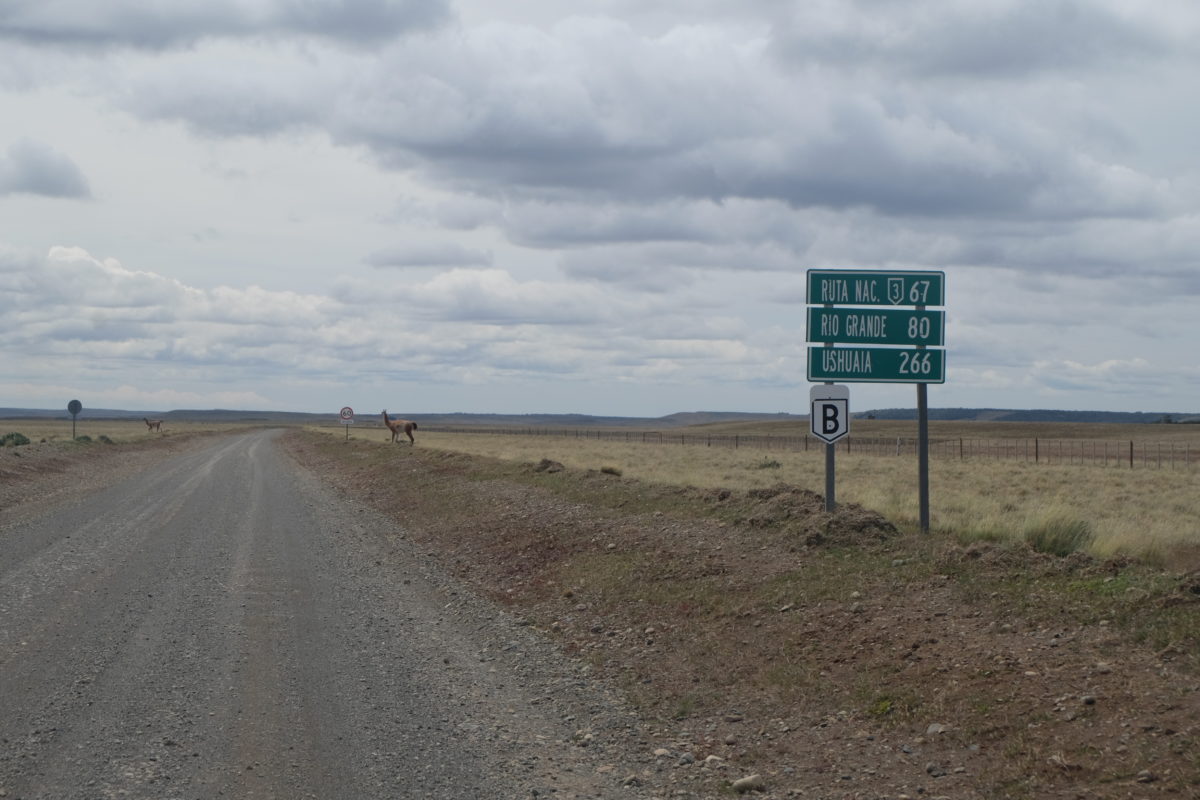
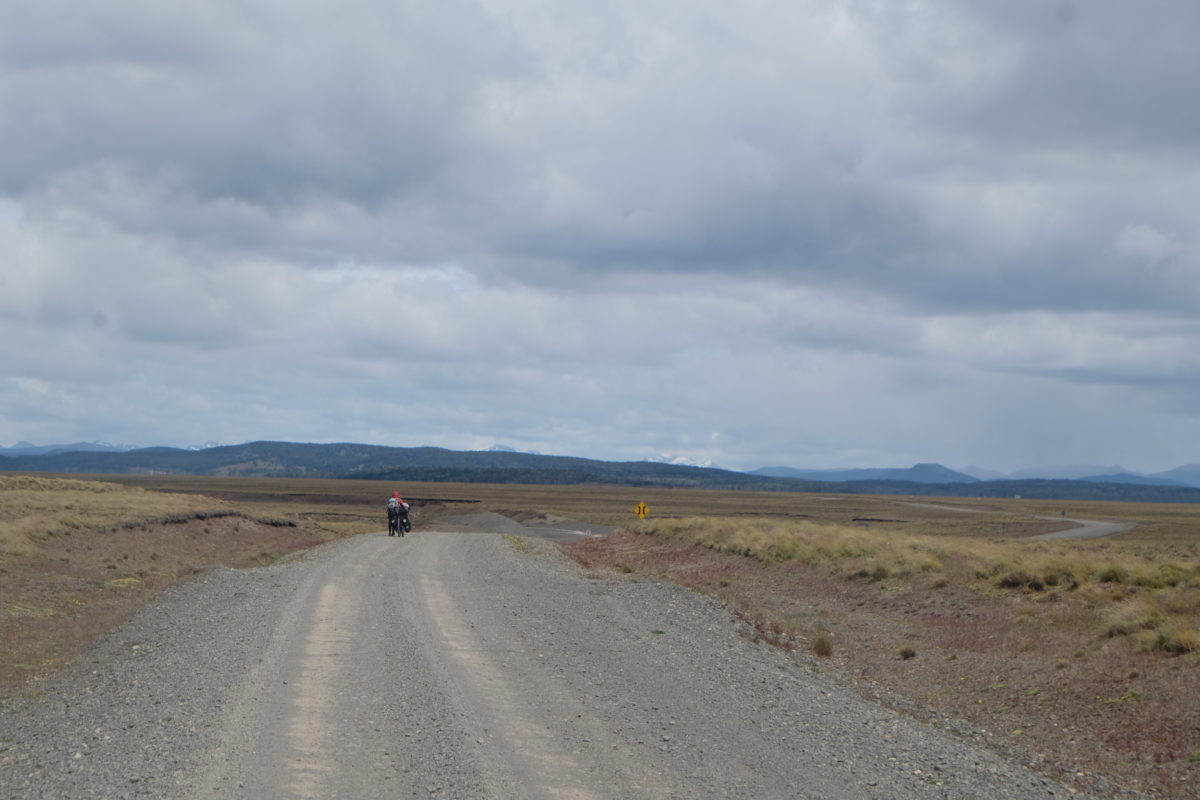
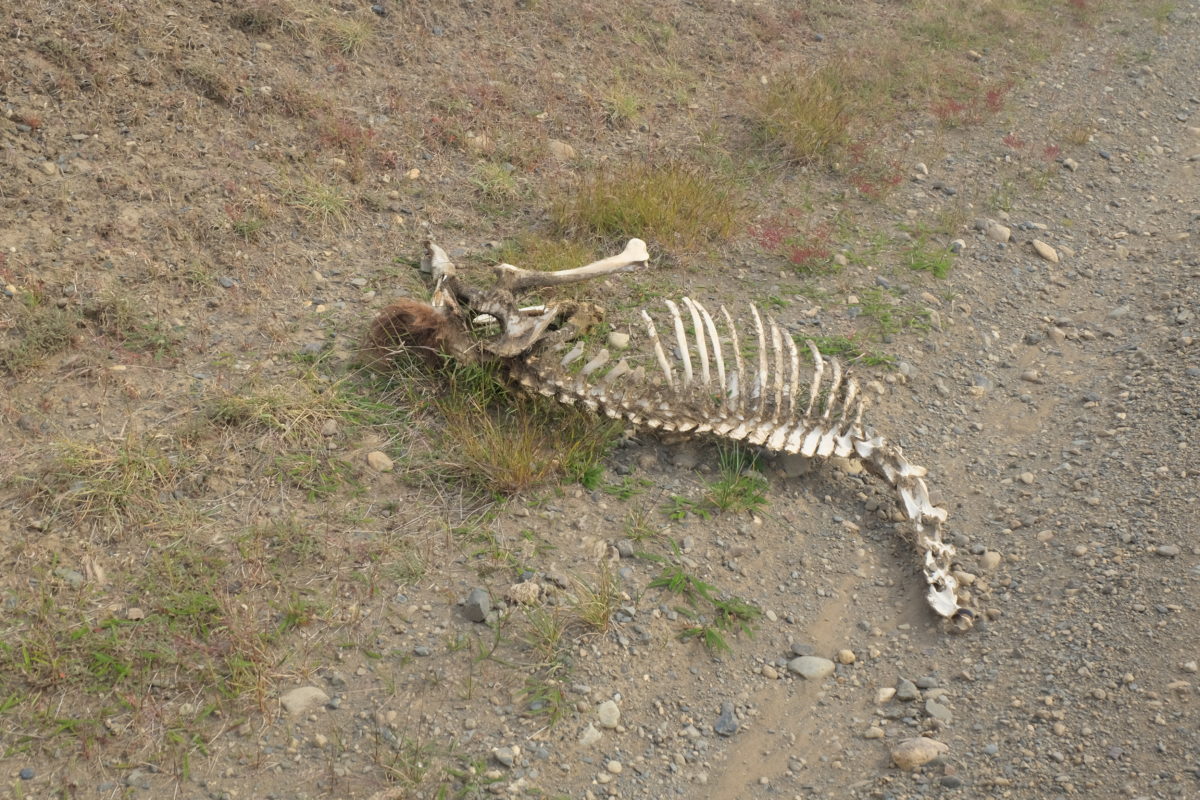
Later that afternoon I was getting tired, but in my opinion I was also too close to Río Grande now to stop and camp now. On this last part were also no good places to sleep or fill up on water, so I really had no choice. I set my daily ripio riding record at 132 kilometers before reaching pavement. Long may it stand, I don’t want to repeat that anytime soon. And without the wind it would certainly not have worked.
Then I followed Ruta Nacional 3 the “wrong” way to the city, which looks industrial and boring as far as I’ve seen now. To top off the day I rode against the wind for a few kilometers before the road turned east to take me into town. After seeing many stupid drivers I had just about had enough, so I took the chance to yell at one who kept driving next to me to let her passenger film me, while the driver herself was also looking at me instead of the road. I hope you enjoy your angry cyclist video.
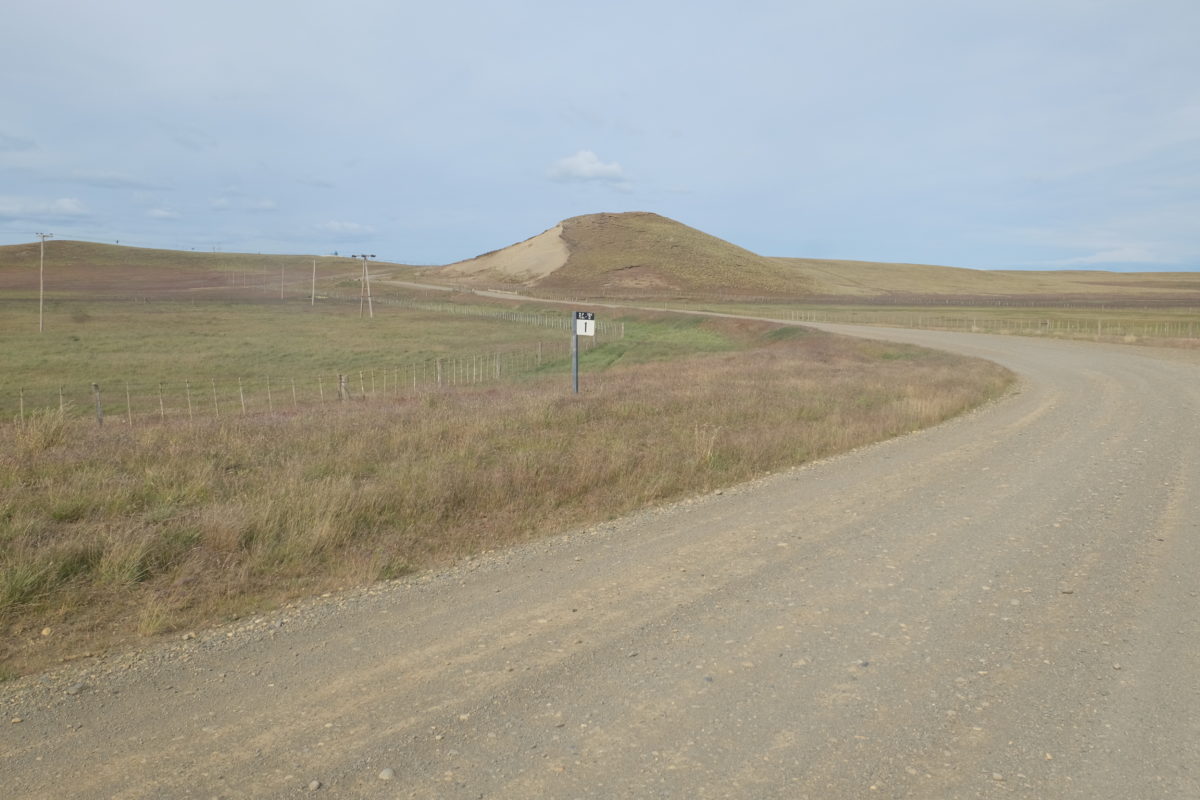
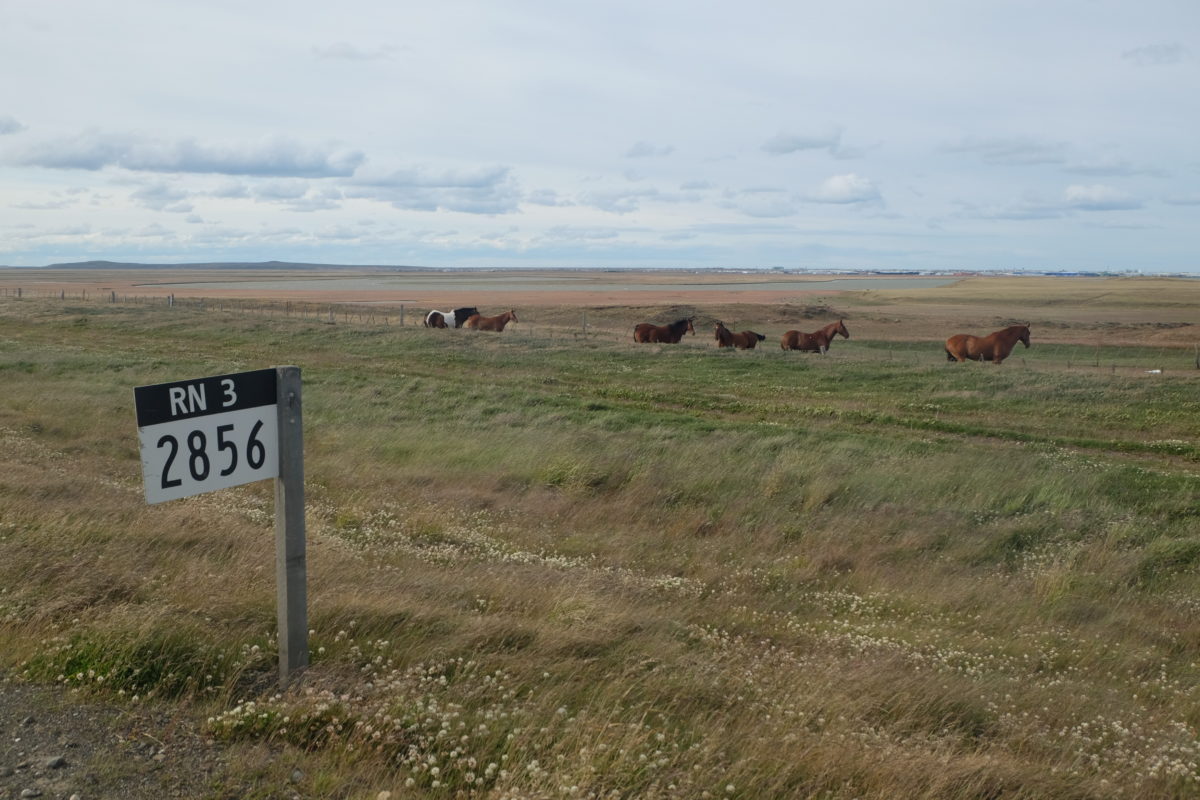
When Magellan first sailed the sea strait that would later be named after him he saw fires on the coast of this island, so he named it the land of fire. No matter how appropriate this name may be for the end of the world, it does not really describe the place. I did not see fire anywhere outside of stoves and such, nor is there volcanic activity. A more appropriate name would have been Tierra del Viento, the land of the wind. It isn’t blowing all the time, but often and strong enough to be a major factor in everything you do here. Just look at the photos of trees for evidence.
I got me a room to stay in tomorrow, so I’ll be here for the new year. I don’t know yet what to do with the extra day I gained. I can hang around somewhere (here, Tolhuin or Ushuaia) or I can take another gravel detour to spend it on the road. And this time I’m certain that will take an extra day.
Río Grande is about as close as you can get to the Falkland Islands without actually going there, so the whole Malvinas Argentinas thing reaches a new high. The boulevard on the ocean shore is named Héroes de Malvinas and on it are many monuments to the people who fought and died in the war. There is also a little museum about it here. Ushuaia is a close second with its airport named Aeropuerto Internacional de Ushuaia Malvinas Argentinas.
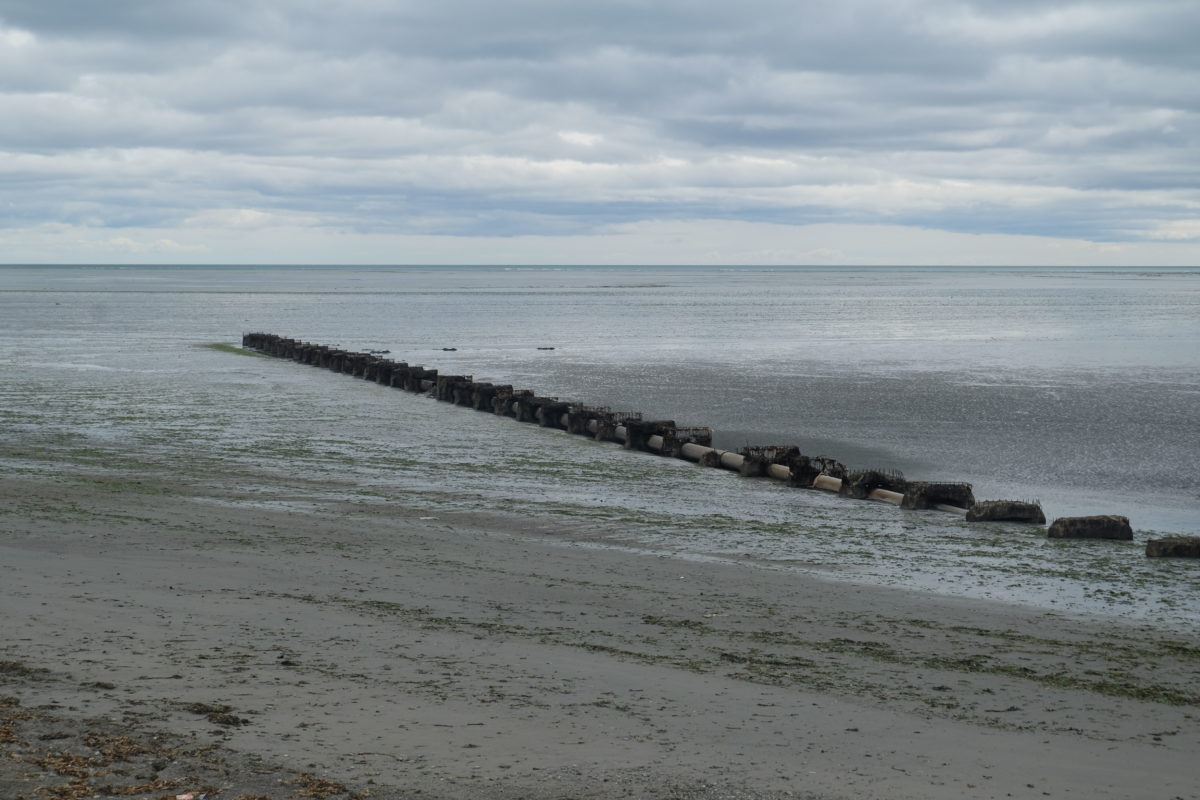
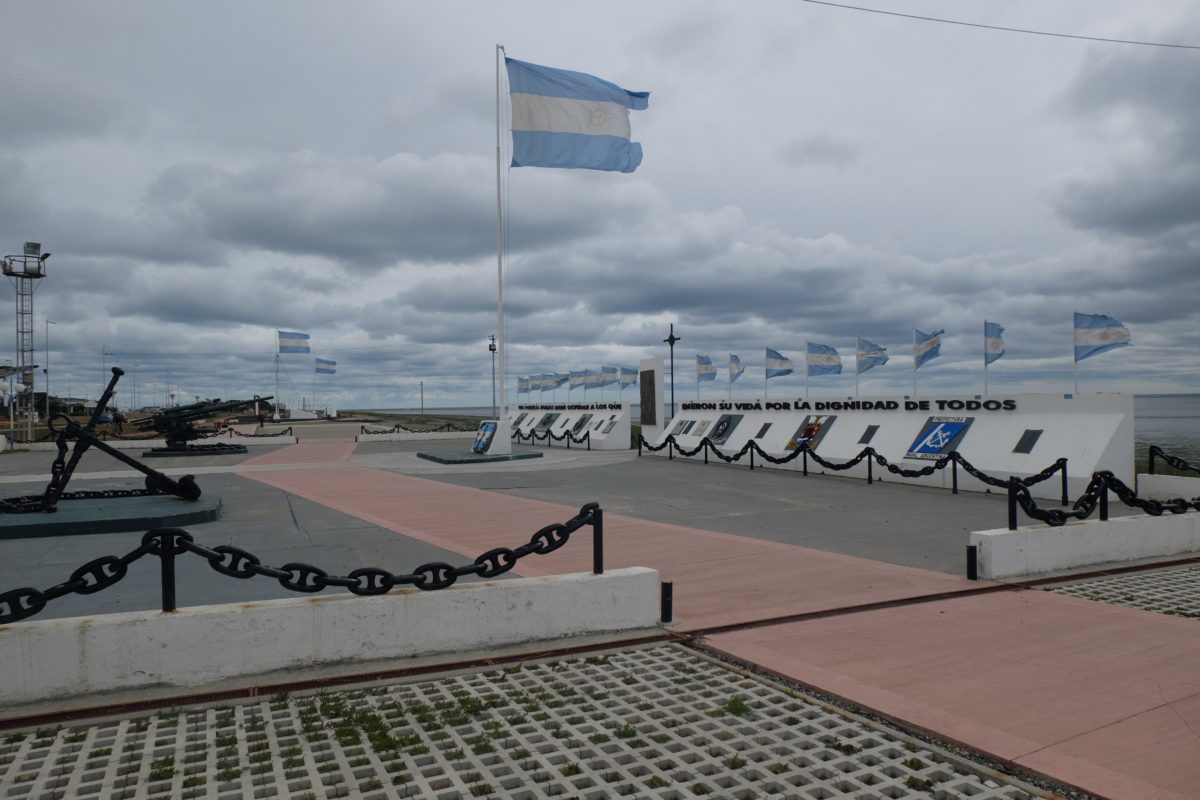
Distance covered: 346.2 km. Total so far: 5611 km.
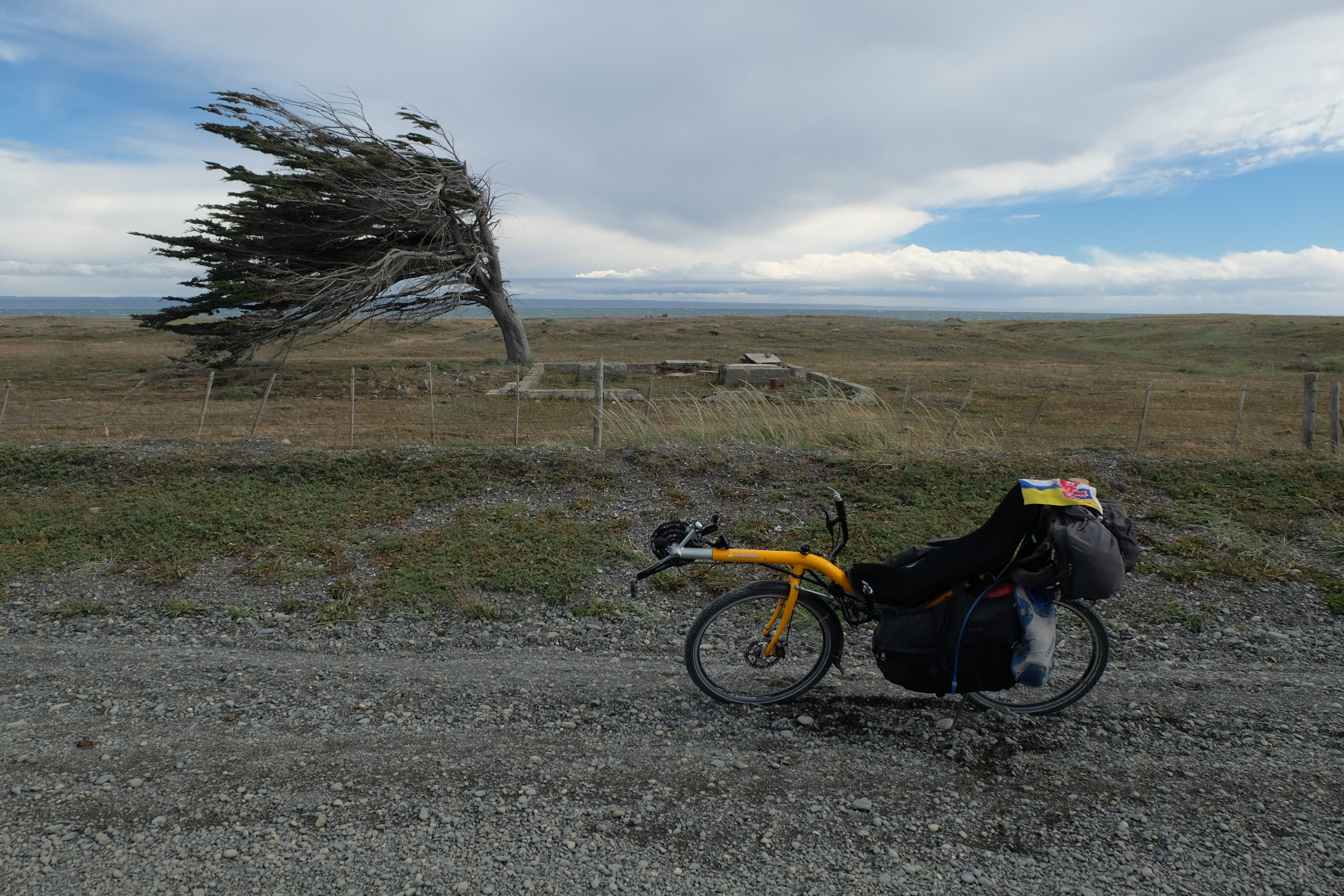
`t zuut t`r nao oet desse dien doel geis haole , door dien waersigheit of gewueën óm desse bès waem se bès !!! geniet van dien lètste kilomaeters en we zeen dich gaer truuk in NAER
en aoh jao , de bèste winse väör 2018 !!!!! väör dich is `t noe ouch noejaor
Stef auk van ôs de beste winse veur dit nieje jaor! Nog ff de letste luudjes dao, geneet der nog van! (Zeen we dich met baard hee truuk?)
Groetjes!
ik wens je een gelukkig nieuwjaar, en tot in Neer.
groetjes oma